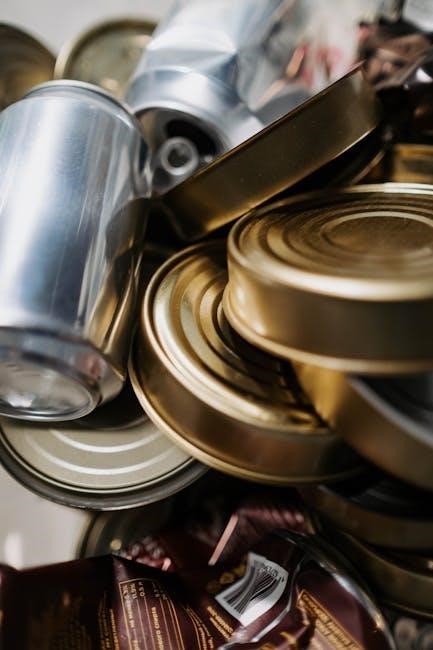The scrap metal identification guide pdf provides general information on recycling and sorting various metal scraps using
specific guidelines
and descriptions for accurate identification always online now.
Importance of Scrap Metal Recycling
The importance of scrap metal recycling cannot be overstated, as it plays a crucial role in conserving natural resources and reducing waste. According to the scrap metal identification guide pdf, recycling scrap metal helps to decrease the need for mining and extracting metals from the earth, which can have devastating environmental consequences. By recycling scrap metal, we can also reduce the amount of energy needed to produce new metals, which in turn reduces greenhouse gas emissions and helps to combat climate change. Additionally, recycling scrap metal helps to conserve landfill space and reduces the risk of environmental pollution. The scrap metal identification guide pdf provides valuable information on the importance of scrap metal recycling and how it can be done effectively. It also outlines the various benefits of recycling scrap metal, including economic benefits, environmental benefits, and social benefits. Overall, recycling scrap metal is essential for a sustainable future.
Overview of Scrap Metal Types
The scrap metal identification guide pdf provides an overview of the different types of scrap metal, including ferrous and non-ferrous metals. The guide categorizes scrap metal into various types, such as copper, aluminum, and steel, and provides descriptions of each type. The guide also includes information on the different forms that scrap metal can take, such as scrap metal wire, scrap metal pipes, and scrap metal sheets; Additionally, the guide provides information on the various sources of scrap metal, including industrial scrap, consumer scrap, and demolition scrap. The scrap metal identification guide pdf is a valuable resource for anyone looking to learn more about the different types of scrap metal and how to identify them. The guide is easy to use and understand, making it a great tool for both beginners and experienced scrap metal recyclers. The guide is available online for easy access.

Non-Ferrous Metal Scrap
Non-ferrous metal scrap includes copper, aluminum, and zinc, with guidelines for identification and recycling always available online now easily.
Characteristics of Non-Ferrous Metals
Non-ferrous metals have distinct characteristics that set them apart from ferrous metals, including higher corrosion resistance and lower magnetic properties, making them ideal for various applications.
The scrap metal identification guide pdf outlines these characteristics in detail, providing information on the physical and chemical properties of non-ferrous metals.
This guide is essential for individuals involved in the recycling and sorting of metal scraps, as it enables them to accurately identify and categorize different types of non-ferrous metals.
The characteristics of non-ferrous metals are also influenced by their alloy composition, which can affect their strength, durability, and conductivity.
Understanding these characteristics is crucial for the efficient recycling and reuse of non-ferrous metals, reducing waste and promoting sustainability.
The guide provides a comprehensive overview of the characteristics of non-ferrous metals, including their density, melting point, and reactivity, making it a valuable resource for professionals and individuals involved in the metal recycling industry.
With this knowledge, individuals can make informed decisions about the identification, sorting, and recycling of non-ferrous metals, contributing to a more environmentally friendly and responsible metal recycling practice.
Examples of Non-Ferrous Metal Scrap
The scrap metal identification guide pdf provides a list of examples of non-ferrous metal scrap, including copper wire, aluminum cans, and zinc-coated steel.
These examples are categorized based on their composition and properties, making it easier to identify and sort them.
The guide also includes information on the sources of non-ferrous metal scrap, such as household waste, industrial waste, and electronic waste.
Some common examples of non-ferrous metal scrap include brass fixtures, bronze alloys, and titanium alloys.
The guide provides detailed descriptions of each type of non-ferrous metal scrap, including their physical characteristics and chemical composition.
This information is essential for individuals involved in the recycling and sorting of metal scraps, as it enables them to accurately identify and categorize different types of non-ferrous metals.
The examples provided in the guide are comprehensive and cover a wide range of non-ferrous metal scrap, making it a valuable resource for professionals and individuals involved in the metal recycling industry, helping them to identify and process non-ferrous metal scrap efficiently.
Ferrous Metal Scrap
Ferrous metal scrap includes iron and steel using
specific guidelines
for accurate identification always online now every day.
Characteristics of Ferrous Metals
Ferrous metals are typically characterized by their high iron content, which can range from a few percent to almost pure iron. The presence of iron in these metals gives them a distinctive set of properties, including high strength, durability, and magnetic properties. Ferrous metals can be further divided into several subcategories, including cast iron, steel, and wrought iron, each with its own unique characteristics and applications. The
scrap metal identification guide pdf
provides detailed information on the characteristics of ferrous metals, including their composition, properties, and common uses. This information is essential for accurate identification and sorting of ferrous metal scrap, which is critical for efficient and effective recycling. By understanding the characteristics of ferrous metals, recyclers and scrap metal dealers can better identify and process these materials, helping to conserve natural resources and reduce waste. The guide also includes tips and best practices for handling and processing ferrous metal scrap.
Examples of Ferrous Metal Scrap
The scrap metal identification guide pdf lists various examples of ferrous metal scrap, including old cars, appliances, and construction materials. These items are commonly found in scrap yards and recycling facilities, and can be recycled to produce new steel products. Other examples of ferrous metal scrap include steel beams, plates, and pipes, as well as cast iron pipes and machinery. The guide also provides information on how to identify and sort these materials, including tips on how to recognize different types of ferrous metals and how to prepare them for recycling. By understanding what types of ferrous metal scrap are available, recyclers and scrap metal dealers can better identify and process these materials, helping to conserve natural resources and reduce waste. The guide is a valuable resource for anyone involved in the scrap metal industry, providing detailed information on ferrous metal scrap and how to recycle it effectively.

E-Scrap Metal Identification
The guide covers electronic scrap metal identification using
specific
online resources always available now online today easily;
Importance of E-Scrap Recycling
The importance of e-scrap recycling cannot be overstated, as it helps to conserve natural resources and reduce the environmental impacts of mining and processing raw materials. According to the guide, recycling e-scrap can also help to reduce greenhouse gas emissions and mitigate the effects of climate change. Additionally, e-scrap recycling can help to recover valuable metals such as copper, gold, and silver, which can be reused in the production of new products. The guide provides information on the benefits of e-scrap recycling and how it can be done in a responsible and sustainable manner. By following the guidelines outlined in the scrap metal identification guide pdf, individuals and organizations can play a crucial role in reducing waste and promoting a more circular economy. The guide is an essential resource for anyone looking to make a positive impact on the environment. Recycling e-scrap is a critical step towards a more sustainable future.
Examples of E-Scrap Metal
The scrap metal identification guide pdf provides examples of e-scrap metal, including discarded electronic devices such as computers, smartphones, and televisions. Other examples include batteries, cables, and circuit boards. These items contain valuable metals like copper, gold, and silver that can be recovered and reused. The guide also mentions that e-scrap metal can be found in household appliances, such as refrigerators and air conditioners. Additionally, items like keyboards, mice, and printers are also considered e-scrap metal. The guide helps individuals and organizations identify and categorize these items, making it easier to recycle them properly. By understanding what constitutes e-scrap metal, people can make a positive impact on the environment by recycling these items and reducing waste. The guide is a valuable resource for anyone looking to recycle e-scrap metal and contribute to a more sustainable future with proper recycling methods and techniques.
